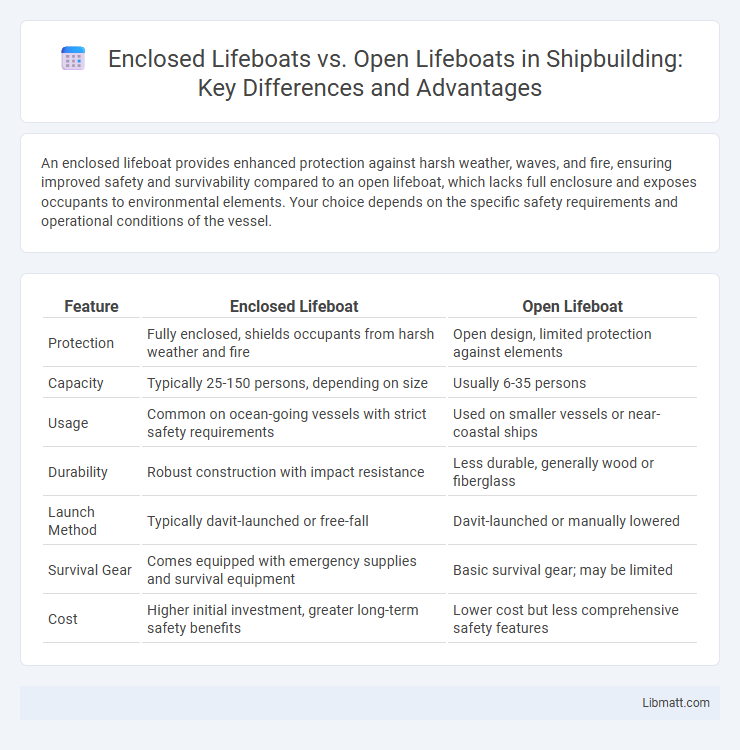An enclosed lifeboat provides enhanced protection against harsh weather, waves, and fire, ensuring improved safety and survivability compared to an open lifeboat, which lacks full enclosure and exposes occupants to environmental elements. Your choice depends on the specific safety requirements and operational conditions of the vessel.
Table of Comparison
| Feature | Enclosed Lifeboat | Open Lifeboat |
|---|---|---|
| Protection | Fully enclosed, shields occupants from harsh weather and fire | Open design, limited protection against elements |
| Capacity | Typically 25-150 persons, depending on size | Usually 6-35 persons |
| Usage | Common on ocean-going vessels with strict safety requirements | Used on smaller vessels or near-coastal ships |
| Durability | Robust construction with impact resistance | Less durable, generally wood or fiberglass |
| Launch Method | Typically davit-launched or free-fall | Davit-launched or manually lowered |
| Survival Gear | Comes equipped with emergency supplies and survival equipment | Basic survival gear; may be limited |
| Cost | Higher initial investment, greater long-term safety benefits | Lower cost but less comprehensive safety features |
Introduction to Lifeboat Types
Enclosed lifeboats offer enhanced protection from harsh weather and rough sea conditions, providing a fully covered environment that shelters occupants from wind, waves, and cold temperatures. In contrast, open lifeboats are exposed and simpler in design, offering minimal protection but easier access and quicker deployment in emergencies. The choice between enclosed and open lifeboats depends on factors such as vessel size, operating environment, and regulatory safety requirements.
Overview of Enclosed Lifeboats
Enclosed lifeboats offer robust protection from harsh weather, fire, and rough seas, enhancing crew safety during maritime emergencies. Constructed with durable materials like fiberglass or steel, these lifeboats are equipped with self-righting features, making them reliable in turbulent conditions. Their sealed design provides shelter against wind, rain, and waves, ensuring greater survivability compared to open lifeboats.
Overview of Open Lifeboats
Open lifeboats are traditional, uncovered vessels designed for emergency evacuation at sea, typically accommodating a small group of survivors in harsh maritime conditions. Constructed with buoyant materials and equipped with basic survival gear, these boats prioritize rapid deployment and ease of boarding during emergencies. Despite their exposed design, open lifeboats remain a vital safety feature on many ships, especially where enclosed lifeboats may not be feasible due to size or cost constraints.
Key Design Differences
Enclosed lifeboats feature a fully covered, rigid structure designed to protect occupants from harsh weather, waves, and fire, incorporating ventilation and navigation aids for enhanced safety. Open lifeboats have minimal covering, relying on manual rowing or motor propulsion, suitable for calmer conditions but exposing occupants to environmental hazards. Your choice between enclosed and open lifeboats should consider these design differences to ensure optimal safety and survival in maritime emergencies.
Safety Features Comparison
Enclosed lifeboats offer superior safety features compared to open lifeboats, including full protection from harsh weather, waves, and hypothermia, and they are equipped with built-in flotation and stability systems to prevent capsizing. Open lifeboats lack protective covers, exposing occupants to environmental dangers and increasing the risk of injury or hypothermia, though they may have basic safety gear like life jackets and emergency supplies. The enclosed design significantly enhances survival rates in stormy sea conditions by providing a more secure and controlled environment for passengers.
Capacity and Storage Considerations
Enclosed lifeboats typically offer a higher capacity, accommodating up to 150 persons, and provide enhanced protection from harsh weather conditions, making them ideal for long-term survival situations. Open lifeboats usually have a smaller capacity, ranging from 20 to 50 persons, and require less storage space due to their simpler design. When planning your vessel's safety equipment, consider that enclosed lifeboats demand more storage volume and weight allowances, while open lifeboats offer easier handling and quicker deployment in emergencies.
Launch and Recovery Mechanisms
Enclosed lifeboats utilize advanced launch and recovery mechanisms such as davit systems with winches and release hooks designed for safe deployment in rough sea conditions, ensuring crew protection and rapid evacuation. Open lifeboats often rely on simpler releasing appliances like falls and manual winches, which may require more manual effort and pose higher risks during launch and recovery. Your choice of lifeboat should consider these mechanisms to optimize safety and efficiency during emergency evacuations.
Environmental Suitability and Protection
Enclosed lifeboats provide superior protection against harsh environmental conditions such as extreme cold, high waves, and strong winds, ensuring safer evacuation in rough seas or polar regions. Open lifeboats, while simpler and lighter, expose occupants to elements like rain, wind, and cold, limiting their suitability to milder weather and calmer waters. Your choice should prioritize enclosed lifeboats for enhanced safety and comfort during emergencies in challenging maritime environments.
Regulatory Compliance and Standards
Enclosed lifeboats comply with international safety regulations such as SOLAS (Safety of Life at Sea) and IMO (International Maritime Organization) standards, providing superior protection against harsh marine environments and extreme weather conditions. Open lifeboats meet minimum safety requirements but offer limited shelter and exposure to risk factors, often falling short of SOLAS evacuation efficiency mandates. Regulatory frameworks prioritize enclosed lifeboats for passenger vessels and offshore platforms due to their enhanced survivability and compliance with rigorous testing for stability, fire resistance, and capacity.
Pros and Cons: Enclosed vs Open Lifeboats
Enclosed lifeboats provide enhanced protection from harsh weather, rough seas, and fire, making them ideal for extreme maritime emergencies, but they tend to be heavier and costlier than open lifeboats. Open lifeboats are simpler and lighter, offering easier access and quicker deployment, though they expose occupants to the elements and have less protection against waves and wind. Your choice between enclosed and open lifeboats should balance environmental conditions, vessel type, and safety requirements for optimal emergency preparedness.
Enclosed lifeboat vs open lifeboat Infographic

 libmatt.com
libmatt.com